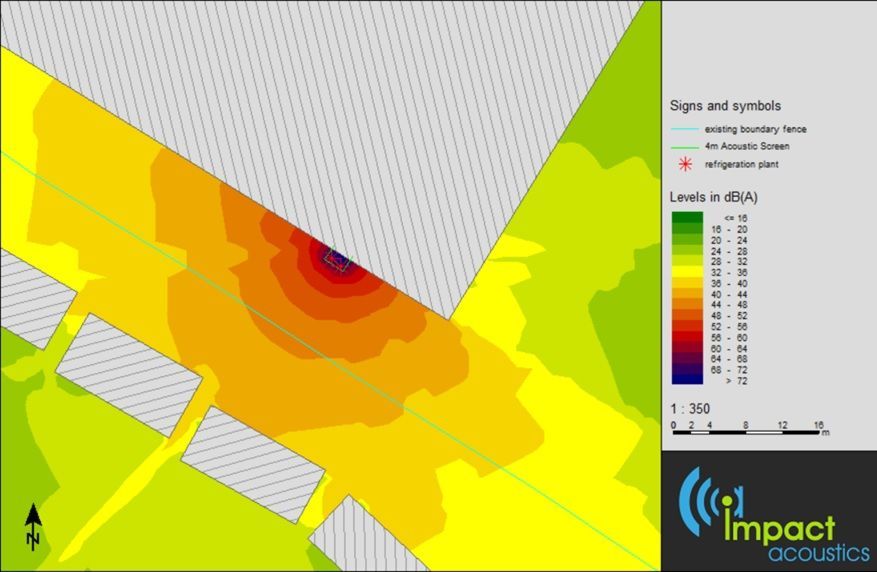Noise at Work Assessment
Factory Employee Noise Exposure
Noise Impact Assessment | Development next to an A road

EXECUTIVE SUMMARY
Impact Acoustics Ltd have been instructed to undertake a background noise impact assessment to British Standard 8233: 2014 to determine the impact of existing A road noise source on the proposed accommodation scheme
The measurements will be undertaken in accordance with ISO 1996 – Part 2: 2017 to determine the existing background noise levels and British Standard 8233: 2014 will be used to determine the impact of existing traffic on the internal noise environment within the proposed residential dwellings. This report aims to establish the following:
- Existing background noise levels with reference to the Aroad in accordance with ISO1996-2:2007;
- A 3D working noise model of the site with reference to the entered and calibrated measured noise levels per position and noise source. This will allow an understanding of the resulting noise levels per daytime, night time and Lmax at any point within the site;
- Assess the potential internal noise levels on the proposed residential properties both with the BS8233:2014 calculation methodology as well as with a partially open window;
- Provide specifications for the ventilation and window glazing with the proposed residential properties;
- Assess the impact of environmental noise within external amenity space;
A background noise survey was undertaken at the site boundary to establish the underling background noise levels. The maximum day time levels were found to be LAeq, 16 hour 65 dB and the maximum night time levels were found to be LAeq, 8 hours 55 dB.
A detailed noise map was produced and it indicated that the maximum noise levels that are likely to be present at the proposed residential façade will during the day time period be LAeq, 16 hour 57.8 dB and during the night time period be LAeq, 8 hours 47.8 dB.
Detailed calculations indicated that internal noise levels within the proposed residential properties will comply with the requirements of British Standard 8233: 2014.
Risk Assessment
Daytime (07:00-23:00)
Risk Assessment Category
1 – Low At Low noise levels, the site is likely to be acceptable from a noise perspective provided that good acoustic design process is followed and is demonstrated in an ADS which confirms how the adverse impacts of noise will be mitigated and minimised in the finished development
1.5.2 Night Time (23:00-07:00)
Risk Assessment Category
1 – Low At Low noise levels, the site is likely to be acceptable from a noise perspective provided that good acoustic design process is followed and is demonstrated in an ADS which confirms how the adverse impacts of noise will be mitigated and minimised in the finished development
Requirements for noise mitigation
In order to meet reasonable internal levels in accordance with BS8233:2014; all facades should implement the following mitigation measures:
Construction of Walls Standard masonry construction
Construction of Ceiling 2 layer of 12mm Fireline plasterboard
Construction of Windows 4/16/4
Construction of Ventilation MVHR
Detailed calculations indicated that internal noise levels within the proposed residential properties will comply with the requirements of British Standard 8233: 2014.
Resulting Internal Levels calculated in accordance with BS8233:2014 per time period
Conclusion Summary
Ambient Noise BS 8233: 2014
The dominant noise source on the overall site is the A Road. Noise Levels have been recorded and assessments made in accordance with the relevant standards. Internal criteria’s have been set and calculations made in order to determine the minimum construction details required in order to meet the desired level within the proposed residential dwellings and satisfy the local council’s requirements.
1.7.2 Planning Recommendation
National Planning Policy Framework 2021 suggests that planning permission should be granted unless any adverse impacts of doing so would significantly and demonstrably outweigh the benefits, when assessed against the policies in the framework taken as a whole, or specific policies in the framework indicate the application should be restricted.
Based on the calculations and assessments made within this report it is the professional opinion of Impact Acoustics Ltd that the proposed development can demonstrate compliance with the National Planning Policy Framework 2021, NPPF & NPSE and that, with regards to sound, planning permission can be granted.


